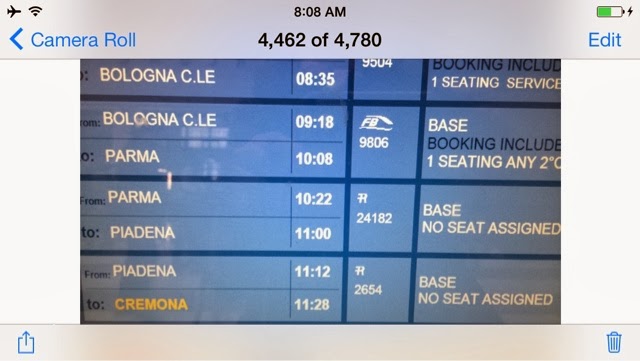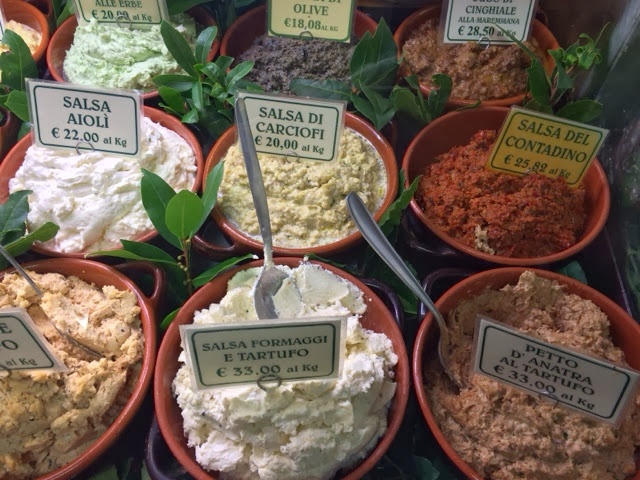I stood in line at one of the help desks. Both a man and a woman where available to ask questions. It was a good system, because while he helped me, the girl was able to help another customer.
Now I know what to do. Go to another ticket machine. Choose the correct option. Hold up the voucher to the screen, lining up the scanning link. The machine asks for some ID. I only had my California drivers license. It liked that and promptly dispensed my change. The whole process took only a few minutes.
At Pescia: Students were waiting for our train and the one going back towards Firenze, which had also just arrived. High school students. These kids look so well dressed. I feel sloppy carrying my water, umbrella and other travel essentials in my COOP canvas shopper. I keep looking for a proper tote. Perhaps I'll be lucky today. I see plastic enclosed green houses out my window. This must be a transportable plant growing area. Rows of young olive trees in containers. It's overcast but I saw no rain in today's weather forecast. This is my first time visiting the walled city of Lucca, home of composer Puccini. Lucca: in just an hour, I've arrived. When exiting the train from Firenze, take the under corridor to the left.
At the tourist office I bought map for 1€.
I first bought from Taddeucci Pastisccetia two loaves of Buccellato bread for 4.50€. Alessio told me it is only made in Lucca. I see it's made with flour, sugar, eggs, raisins, anise and vanilla. Can't wait to have a piece later with milk. For dessert today I also, bought sweets.
I was really hungry when I arrived today, but it took me a little time to find Trattoria da Leo, which had been recommended by Alessio.
It was an hour before closing. They were out of fennel baked with parmigiana, so I chose rigatoni with squash and olives instead of the cotoletta alla milanese
(made with pork).
But after eating all the squash and half the pasta, I ordered the cotoletta, after all. I wanted to taste it here, because I make it at home with both pork and chicken, never with veal. I just remembered something sweet Marco, razaggo of Elisa, said yesterday. I told him I never eat veal because I couldn't eat a baby cow. Puzzled, he said 'but they are two years old.'
I've spent all day walking and taking pictures. It's really an adorable town and I can see why it would be a great place to live. I saw few cars but bikes seem to rule the road here. Also, there a no sidewalks.
I waited my turn to fill my water bottle from this fountain. Good fresh water.
After three attempts, I finally found one of the openings to Piazza dell'Anfireatro. It's oval shaped, large and surrounded on all sides with continuously connected tall buildings.
Sunset was at 4.30, just about the time I entered the piazza. Strange to find the piazza empty. The next train departs at 5.31 (arrival 18.50). While window shopping back, I have given up hope of finding a tote. I had been feeling more and more self conscious carrying the shopping bag. I saw a great bag in a shop specializing in a modular pressed plastic tote. Made in Italy, my favorite color violet and has a black handle and insert. After paying for my 'o bag' I transferred my belongings. What a relief. I'm observing the girls on this train. They all have their own 'look' but it's always put together. I watched one girl, using the window reflection to make adjustments. Pulling her hair down just so, adjusting her winter cap. I need to look in the mirror more often and do the same. If I had, I would never had been carrying that shopping bag!I need to check my lip gloss and hair now before we arrive in Firenze. ~~.~~.~~
From: http://www.italyguides.it/us/italy/tuscany/lucca/squares/piazza-dell-anfiteatro.htm
- Piazza dell'Anfiteatro -
The amphitheatre, built as the centre of entertainment outside the Roman town, is today the centre of town life and the very symbol ofLucca. It is a unique elliptical-shaped plaza, theatre of the life of the citizens of Lucca, closed in an embrace of medieval houses and, in spite of the passing of the millennia, is always alive and witness to innumerable changes.
When its was created, for spectacles and gladiator games, the amphitheatre of Luccawas an imposing structure, with fifty-four arches and a cavea able to hold as many as ten thousand spectators.
Its construction began in the 1st century AD under the Emperor Claudius and was concluded in the Flavian period, generously financed by a rich citizen, as seen from an honorary inscription discovered during excavations in the 1800s. In the Middle Ages, when this area became a plaza, it was called the "Parlascio" and this name was believed to come from "parlare", meaning "to talk", as it was the venue of popular assemblies.
In reality, however, it was a corruption of "paralisium", the Latin for "amphitheatre". In many towns, with the long sieges of the medieval period, the Roman structures were transformed into fortifications.
Lucca's amphitheatre suffered the same fate; during the Gothic Wars, under siege byNarsete, it was fortified and made impenetrable by the closure of the outside arches. When this function too ended, terraced houses were built on the surviving ruined structures, which were also used for construction materials.
These then became a powder magazine, a salt store, a prison which was dubbed the "grotte" (caves) and finally shops and eating places, while the centre of the plaza was divided into portions and in a certain period was used for vegetable patches. It was in the 1800s that an architect of Luca, Lorenzo Nottolini, restored the value of the ancient space making theamphitheatre a fundamental structure for the urban arrangement of the town. The buildings which had crowded the inside of the arena over the centuries were demolished and the new via dell'Anfiteatro surrounded the ancient building.
The city thus gained a new oval space, which followed the same perimeter and the same volumes of the ancient building and was dedicated to the town market (not by chance it is called "Piazza del Mercato") while the originalamphitheatre retained its structures two metres below the road surface, with arches and vaults emerging at the shops that face onto the plaza.
Some of the Roman remains are still visible as we go along via dell'Anfiteatro, in the buildings bounding the plaza and in the lowest of the four arches leading into it, the only one left of the ancient structure.
Sent from my iPhone


































































